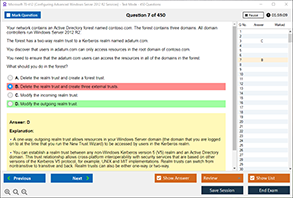Overview of the Cisco 200-301 Exam
The Cisco Certified Network Associate (CCNA) 200-301 exam is one of the most recognized certifications in the field of networking. Administered by Cisco Systems, the CCNA 200-301 exam validates a candidate’s ability to install, configure, operate, and troubleshoot small to medium-sized networks. It's a foundational credential for IT professionals who want to establish or advance their careers in networking and cybersecurity.
Launched as a single consolidated exam in place of previous multiple CCNA tracks, the 200-301 exam covers a wide range of topics including:
-
Network fundamentals
-
Network access
-
IP connectivity
-
IP services
-
Security fundamentals
-
Automation and programmability
The exam consists of approximately 120 questions and must be completed in 120 minutes. Candidates are tested using various formats including multiple-choice, drag-and-drop, and simulation questions. To prepare effectively, understanding core concepts like Protocol Data Units (PDUs) and Network Interface Cards (NICs) is essential.
What Is a PDU (Protocol Data Unit)?
A Protocol Data Unit (PDU) refers to a single unit of data that is transmitted over a network. The concept of PDUs is crucial in networking because it helps us understand how data moves through the different layers of the OSI (Open Systems Interconnection) or TCP/IP model.
Each layer of the OSI model has its own type of PDU:
| OSI Layer | PDU Name |
|---|---|
| Application | Data |
| Presentation | Data |
| Session | Data |
| Transport | Segment |
| Network | Packet |
| Data Link | Frame |
| Physical | Bits |
Let’s break it down further:
-
Application to Session Layers (Layers 7-5): The data remains in a basic 'Data' form.
-
Transport Layer (Layer 4): The data is encapsulated into segments. This layer ensures reliable transmission via protocols like TCP and UDP.
-
Network Layer (Layer 3): The segment becomes a packet with logical addressing (e.g., IP addresses).
-
Data Link Layer (Layer 2): The packet is further encapsulated into a frame with physical addressing (MAC addresses).
-
Physical Layer (Layer 1): The frame is converted into bits and transmitted over physical media like cables or wireless channels.
Understanding PDUs is fundamental to mastering network data flow—a concept heavily tested in the Cisco 200-301 exam.
Network Interface Card (NIC) and Its Function
A Network Interface Card (NIC) is a hardware component that connects a computer to a network. Whether it's Ethernet-based or wireless, the NIC is responsible for converting data between the computer and the network.
Key Functions of a NIC:
-
Data Link Layer Functionality: The NIC operates at Layer 2 of the OSI model and handles MAC addressing, allowing devices to identify each other on a local network.
-
Framing and Error Checking: It structures data into frames and can check for data integrity using CRC checks.
-
Access Control: Determines when the device can send data onto the network using protocols like CSMA/CD.
-
Physical Layer Interaction: Converts digital data into electrical, optical, or radio signals.
-
Full Duplex Communication: Modern NICs support full-duplex mode, meaning data can be sent and received simultaneously.
Cisco 200-301 candidates must understand how NICs interact with PDUs and how they facilitate communication at both the Data Link and Physical layers.
Tips to Remember PDUs for the Cisco 200-301 Exam
Memorizing the names and functions of PDUs at each OSI layer can be a challenge. Here are some practical tips to help Cisco 200-301 candidates remember PDUs effectively:
1. Use Mnemonics
Try the mnemonic "Please Do Not Throw Sausage Pizza Away" to remember the OSI layers from Physical to Application:
-
P – Physical (Bits)
-
D – Data Link (Frames)
-
N – Network (Packets)
-
T – Transport (Segments)
-
S – Session (Data)
-
P – Presentation (Data)
-
A – Application (Data)
2. Create Flashcards
Write each OSI layer on one side and the corresponding PDU on the other. Regular review will reinforce memory.
3. Visualize Data Encapsulation
Drawing the data encapsulation process helps solidify understanding. Show how each layer adds headers or trailers to form the next-level PDU.
4. Practice with DumpsBoss Exam Questions
Nothing beats repetition with real-world scenarios. DumpsBoss provides authentic Cisco 200-301 exam questions that cover PDUs, NICs, and many more concepts.
5. Teach Someone Else
Explaining PDU concepts to a peer or even out loud to yourself can help reinforce your understanding and highlight any gaps in knowledge.
Where to Find Real Cisco 200-301 Exam Dumps
When it comes to finding authentic and updated Cisco 200-301 exam dumps, look no further than DumpsBoss.
Why Choose DumpsBoss for Cisco 200-301 Preparation?
Updated Questions: All dumps are regularly reviewed to reflect the latest exam format and question patterns.
Expert-Verified Answers: Each answer is vetted by certified networking professionals to ensure accuracy.
Comprehensive Coverage: Our dumps span all major exam topics including network fundamentals, access control, IP services, automation, and security.
Accessible Formats: DumpsBoss provides practice questions in PDF and online test engines, perfect for on-the-go studying.
Real Exam Scenarios: Many DumpsBoss questions are modeled after real-world scenarios to help candidates apply theoretical knowledge effectively.
How to Use Cisco 200-301 Dumps Effectively:
-
Start with a diagnostic test to identify weak areas.
-
Review questions by topic, focusing on your low-scoring areas first.
-
Use the explanations provided to understand the rationale behind each correct answer.
-
Simulate real exam conditions using the online test engine.
-
Repeat until you consistently achieve high scores across all sections.
By integrating DumpsBoss resources into your study plan, you’ll greatly increase your chances of passing the Cisco 200-301 exam on your first attempt.
Conclusion
The Cisco 200-301 CCNA exam is a critical step in launching a successful career in networking. Key concepts like Protocol Data Units (PDUs) and the function of Network Interface Cards (NICs) form the foundation of many exam questions.
Understanding how PDUs are used across different OSI layers—and how NICs enable network communication—gives you the edge needed to answer technical questions confidently. Combined with the right study tools, like the verified exam dumps from DumpsBoss, you'll be well-equipped to ace the exam.
Whether you're a newcomer to networking or brushing up your skills, DumpsBoss is your trusted partner for real, updated, and reliable Cisco 200-301 exam dumps. Start preparing today and take your career to the next level!
Special Discount: Offer Valid For Limited Time “200-301 Exam” Order Now!
Sample Questions for Cisco 200-301 Dumps
Actual exam question from Cisco 200-301 Exam.
Which PDU (Protocol Data Unit) format is used when bits are received from the network medium by the NIC of a host?
A) Frame
B) Packet
C) Segment
D) Data



